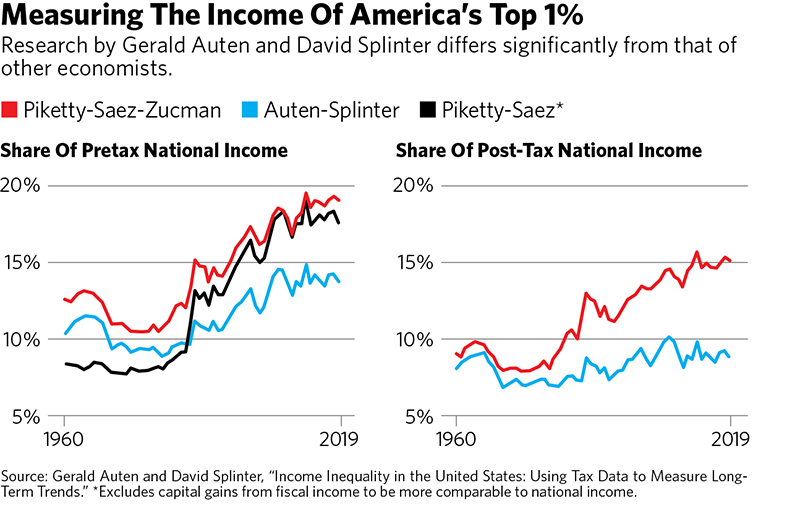Can a single self-published paper really refute decades of work by three famous economists? If the paper is the modestly titled “Income Inequality in the United States: Using Tax Data to Measure Long-Term Trends,” then the answer—with qualifications—is yes.
Some background: Economists Thomas Piketty, Emmanuel Saez and Gabriel Zucman have written extensively about wealth and income inequality. From their academic posts at the School for Advanced Studies in the Social Sciences in Paris and the University of California at Berkeley, they (and others) have made a more specific claim: When it comes to income, the top 1% in the U.S. has pulled away from the pack. Their finding became so deeply ingrained in the public consciousness that it was embodied in an Occupy Wall Street slogan, “We are the 99%!”

It now seems this claim is wrong, or at the very least unproven. That is partly because of the work of Gerald Auten and David Splinter, both of whom work for the U.S. government (the Treasury Department and the congressional Joint Committee on Taxation, respectively). Both have stellar reputations for understanding what the numbers mean; their previous papers had significant impact on how tax data is understood.
Now, in their latest study, they arrive at a conclusion that will be startling to a lot of people: “Increasing government transfers and tax progressivity have resulted in rising real incomes for all income groups and little change in after-tax top income shares.”
More concretely, in terms of pretax income, the share of the top 1% has gone up only 2.6 percentage points since the early 1960s. For after-tax income, top income shares haven’t changed much at all.
Auten and Splinter have a methodological explanation for why their results differ. The share of true income missing in tax data has increased over time, and they attempt to adjust for that discrepancy, as well as for the way income sheltered in corporations has changed. Auten and Splinter also include cash and in-kind transfers for the lower income groups, to better measure their true incomes.
Splinter has explored this theme of underreported income in detail in previous work , directly comparing his results to those of Piketty, Saez and Zucman. It appears that Auten and Splinter really do have more complete numbers.
And the earlier records of Piketty, Saez and Zucman are controversial. Piketty’s bestseller, Capital in the 21st Century, published in English in 2014, attributed wealth inequality (as distinct from income inequality) to superior returns on capital. But the current best understanding is that recent rises in wealth inequality come primarily from real estate holdings. Other researchers (one of whom is my colleague Vincent Geloso) dispute how Piketty and Saez measure U.S. income inequality since 1917. An earlier Saez and Zucman paper assumed that the corporate income tax does not induce capital to shift out of the corporate sector, an improbable assumption.
To be sure, Auten and Splinter are not the first to critique the Piketty-Saez-Zucman theory of the case; Alan Reynolds took it on in his 2006 book Income and Wealth, and Auten and Splinter cite other precursors. To its discredit, the news media did not give these results very prominent coverage—though there were notable exceptions. Nonetheless, these results will not be a surprise to everybody.
At the very least, the presumption in favor of Piketty, Saez and Zucman is now gone. For the time being, there are better arguments, based on better data, that suggest very different conclusions.
None of this, by the way, leads to the conclusion that inequality is not a problem. Gaps in life expectancy are still rising, especially for those in the bottom 10% of the U.S. population, as defined by educational status. Nor do Auten and Splinter’s results contradict the notion that, in relative terms, Bill Gates enjoys a more dominant wealth and income position than Howard Hughes ever did. At the very, very top, it is still likely that income inequality has been rising. It is no accident that there has been a boom in super-yachts.
Still, when it comes to the most commonly cited statistic about income inequality—namely, the ascendancy of the top 1%—the dominant discourse has been misleading, if not outright wrong. While dissent has been brewing for some while, it just hasn’t broken through. I hope that now it will.
The solution is not to do nothing. There are still plenty of major problems among Americans in the lower income and educational strata. But it would be better to treat those as issues in their own right, rather than as part of a strategy to deal with the top 1%. In the meantime, we all should be more careful about leaping too quickly to politically convenient conclusions.
Tyler Cowen is a Bloomberg Opinion columnist, a professor of economics at George Mason University and host of the Marginal Revolution blog.








